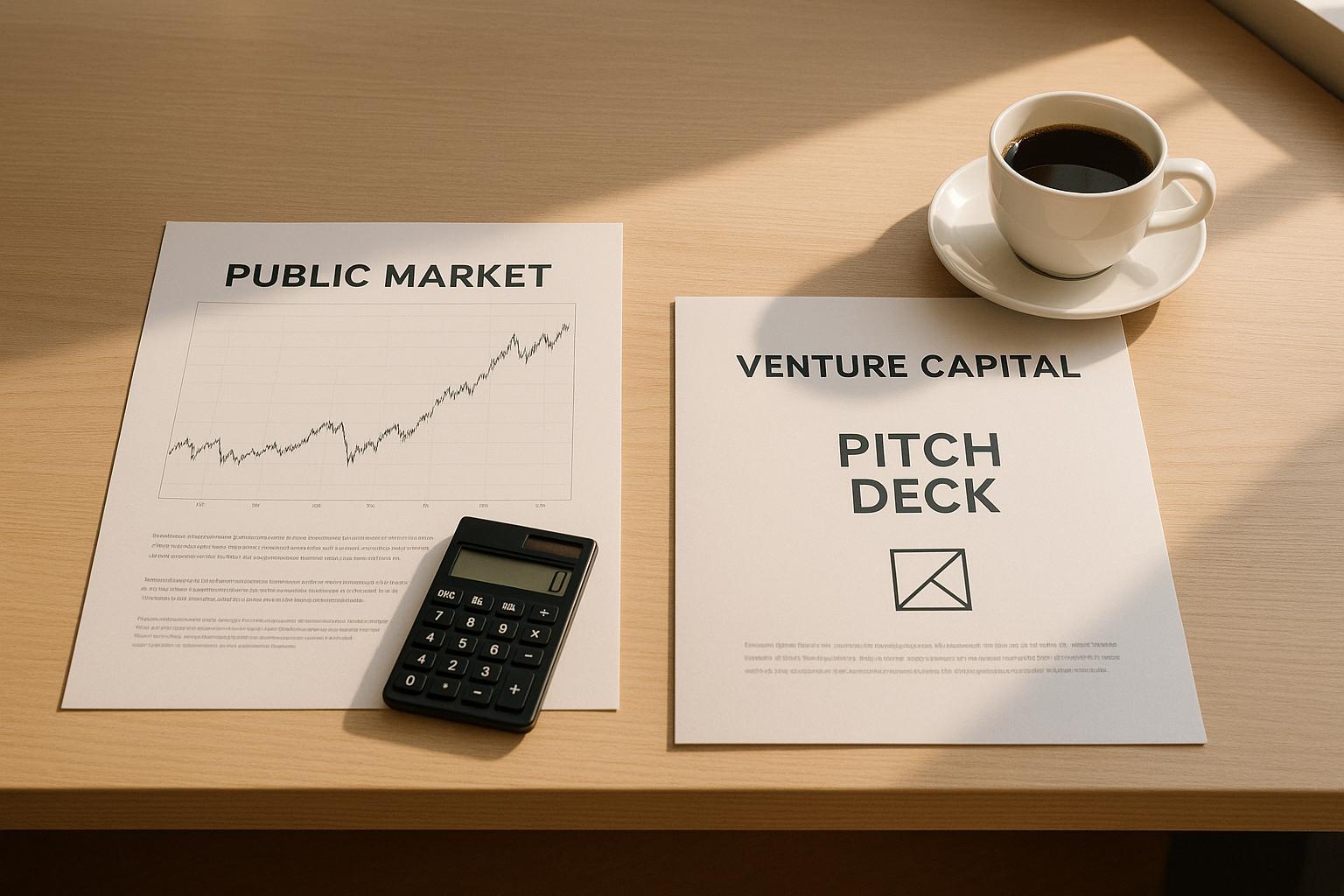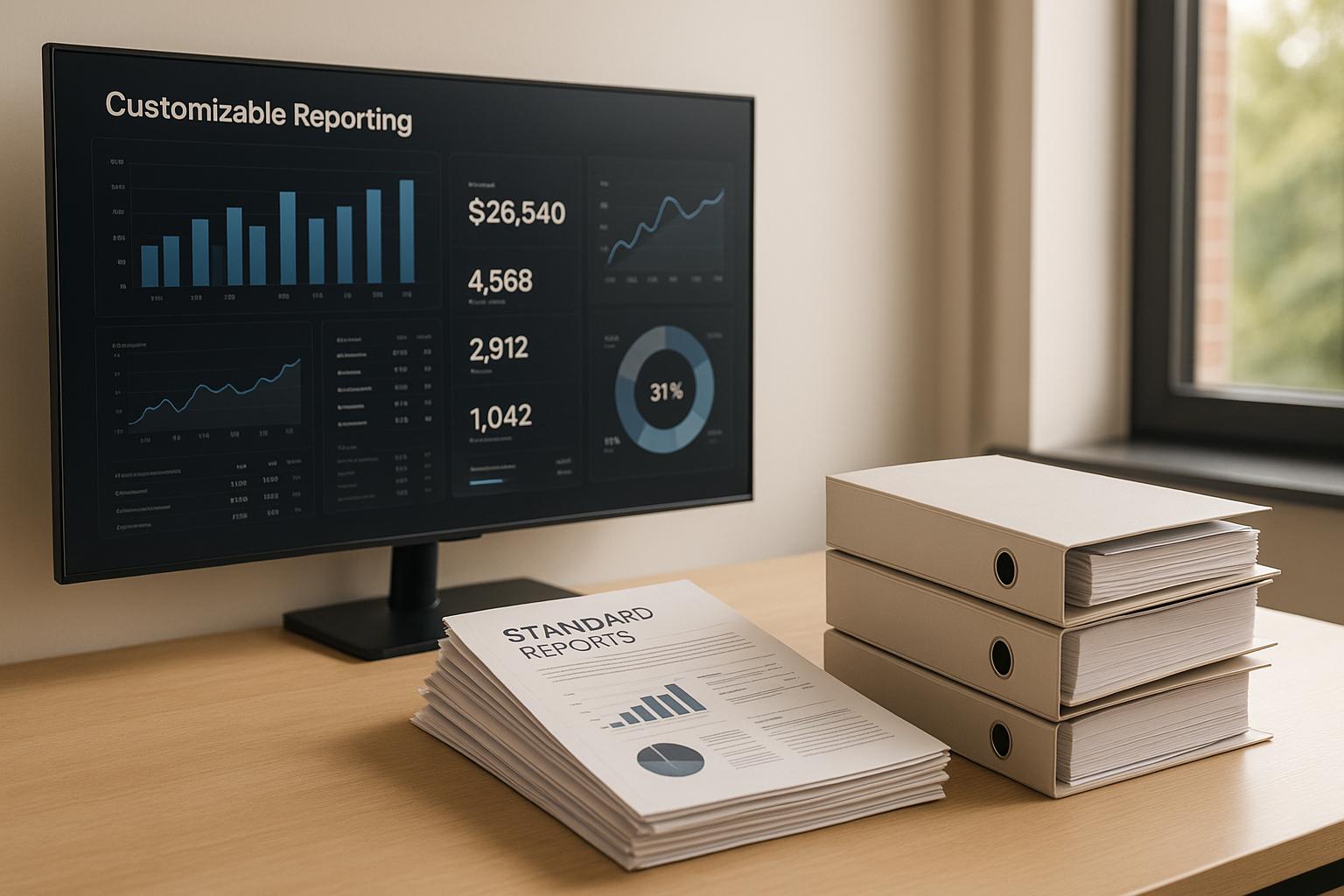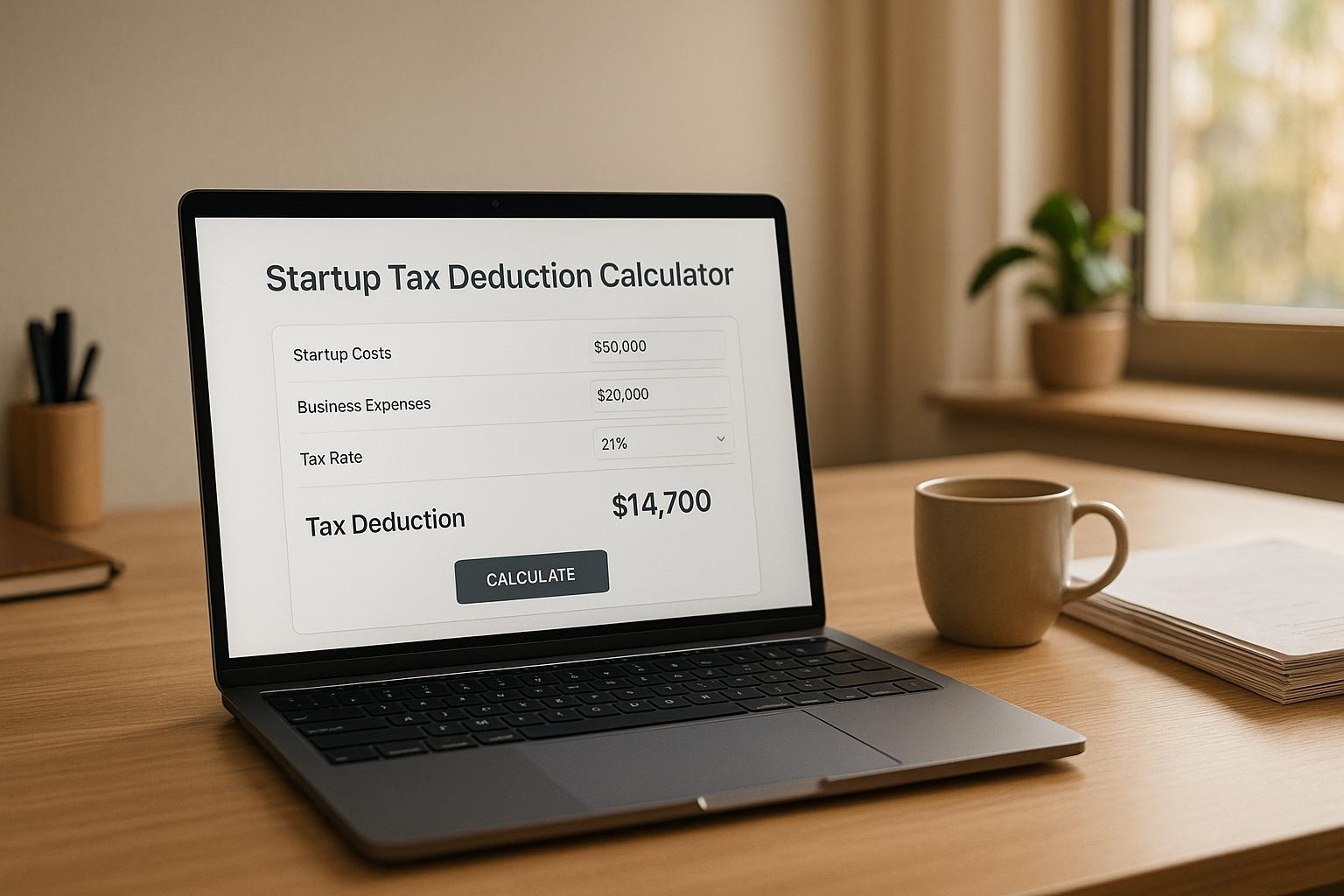VC Returns vs. Market: Risk-Adjusted Metrics Compared

When deciding between venture capital (VC) and public market investments, understanding risk-adjusted returns is critical. This measures how much return you're getting for the risk you take. Here's what you need to know:
- VC investments can deliver high returns (e.g., 38% annualized), but they come with risks like illiquidity (4–10 years) and high failure rates (64% of deals lose principal). Returns are driven by a few big winners.
- Public markets offer steady growth (e.g., S&P 500's 5.9% annualized over 20 years), daily liquidity, and transparency. However, they can be volatile and often underperform top VC funds.
Key Metrics for Comparison:
- VC Metrics: Internal Rate of Return (IRR), Multiples of Invested Capital (MOIC), Public Market Equivalent (PME), Direct Alpha.
- Public Market Metrics: Sharpe Ratio, Treynor Ratio, Jensen’s Alpha.
Quick Facts:
- VC funds outperform public markets about 50% of the time but require patience and a higher risk tolerance.
- Public markets adjust quickly to economic shifts, while VC valuations lag behind.
Quick Comparison
| Factor | Venture Capital | Public Markets |
|---|---|---|
| Return Potential | High (38% annualized, top funds >20%) | Modest (S&P 500: ~5.9% over 20 years) |
| Risk | High (64% of deals fail) | Lower (diversified exposure) |
| Liquidity | Illiquid (4–10 years) | Daily liquidity |
| Time Horizon | Long-term (6+ years) | Flexible |
| Transparency | Limited (infrequent valuations) | Real-time pricing |
For investors, the choice depends on your risk tolerance, liquidity needs, and investment timeline. A mix of both asset types often provides the best balance between growth and stability.
1. Venture Capital Returns
Venture capital returns operate differently from public market investments, making them challenging to measure accurately. Public markets typically use time-weighted returns (TWR), which focus on manager skill by excluding the impact of external cash flows. On the other hand, venture capital relies on internal rate of return (IRR) and multiples of invested capital (MOIC) to account for the timing and illiquidity of private investments. Because of these differences, specialized risk metrics are needed to bridge the gap between private and public investments.
Risk-Adjusted Metrics
To compare venture capital with public markets, investors turn to tailored risk-adjusted metrics. Traditional metrics often fall short in capturing the nuances of venture capital, so more specialized approaches are necessary. One key tool is the Public Market Equivalent (PME), which measures what would have happened if the same capital invested in a VC fund had been allocated to a public market index instead.
Additional metrics like the Kaplan & Schoar PME (where values above 1.0 indicate outperformance), Direct Alpha (which calculates annualized excess returns), PME-based Sharpe Ratio (factoring in volatility), and beta comparisons offer a deeper understanding of value creation and market correlation in venture capital.
Performance Variability
Venture capital returns are far more variable than those in public markets. Rankings for VC funds can shift significantly over time, with 80–90% of private investment funds moving across three different quartiles during their lifecycles. In fact, around 40% of funds will rank in each quartile at some point.
"Venture capital investments are like options; they have a small chance of a huge payoff" – Cochrane 2005
This variability stems from the power law distribution that defines VC returns. Only 10–15% of investments generate the bulk of a fund's returns, with these few successes often driving overall performance. Top-performing VC funds aim for IRRs exceeding 20–30% over the fund's life, while keeping a loss ratio below 40% - a notable achievement in an asset class where failures are common.
Liquidity and Time Horizon
The illiquid nature of venture capital fundamentally changes how risk-adjusted returns are calculated. Unlike public markets, where investments can be traded daily, VC commitments require patience - typically taking at least six years before meaningful performance assessments can be made. It’s during this time that a fund’s ultimate quartile ranking usually solidifies, leaving investors with prolonged periods of uncertainty. This extended timeline also means macroeconomic cycles can heavily influence returns, sometimes affecting entire vintage years of VC investments. To compensate for this lack of flexibility, investors expect an illiquidity premium.
Macroeconomic Sensitivity
Venture capital returns are particularly sensitive to macroeconomic trends, technological shifts, and economic cycles, far more so than diversified public market indices. Growth-stage companies, which dominate VC portfolios, are especially vulnerable to interest rate changes. For instance, rising rates in 2022–2023 led to a significant funding slowdown. Additionally, the growing involvement of corporate venture arms, sovereign wealth funds, and pension funds in VC deals has further shaped how macroeconomic factors impact returns. Despite these challenges, sectors like AI, climate tech, and health tech continue to attract interest due to their potential for long-term growth. However, this focus on specific industries can introduce systematic risks that aren’t always reflected in traditional public market metrics.
With private markets now managing over $8 trillion in assets, developing reliable methods for comparing risk-adjusted returns is becoming increasingly important for institutional portfolio planning.
2. Public Market Returns
Public market returns operate in a completely different sphere compared to venture capital. They thrive on daily liquidity and continuous pricing, offering a level of transparency that private investments often lack. Instead of relying on the intricate internal rate of return (IRR) calculations common in venture capital, public markets use time-weighted returns (TWR). This approach focuses solely on market performance and manager skill, stripping out the influence of external cash flows.
Risk‑Adjusted Metrics
Public markets have long relied on established risk-adjusted metrics to evaluate performance. One of the most popular tools is the Sharpe Ratio, which measures the excess return per unit of volatility based on daily price movements. On the other hand, private markets struggle to measure volatility accurately due to infrequent valuations and the smoothing effects of their pricing models.
To bridge the gap between public and private market returns, tools like the Public Market Equivalent (PME) have been developed. For example, the Kaplan & Schoar PME offers a direct comparison between the two, with values above 1.0 signaling outperformance. Another valuable metric is Direct Alpha, which quantifies the annualized excess return private investments achieve over public benchmarks. These tools are particularly relevant today, as private markets now manage over $8 trillion in assets.
This comprehensive toolkit allows for a clearer understanding of market dynamics and provides a transparent way to assess performance differences.
Performance Variability
Public markets deal with volatility in a much more transparent way than venture capital. While venture capital often experiences extreme swings in returns, public market volatility is immediately visible and measurable. Stock prices reflect real-time economic data and market sentiment, giving investors a clear picture of risk at any given moment.
The continuous evaluation of public market performance is another key feature. Daily price updates allow for precise risk-adjusted analysis and straightforward benchmarking. However, this doesn't mean public markets are immune to variability. For example, hedge funds have consistently underperformed the S&P 500 every year since 2011. This trend underscores how heightened volatility can negatively impact risk-adjusted metrics like the Sharpe Ratio, particularly during periods of market stress.
Liquidity and Time Horizon
Liquidity is one of the defining features of public markets. Investors can convert assets into cash almost instantly during market hours, making it easier to rebalance portfolios or adjust risk management strategies as conditions change. This high liquidity not only supports flexibility but also enables investors to respond quickly to new developments.
Public market investments also come with a flexible time horizon. Investors can adjust their strategies as new information becomes available - whether it's a macroeconomic shift, sector rotation, or company-specific news. In contrast, venture capital demands a long-term commitment, with performance often taking years to materialize. This flexibility gives public market managers more opportunities to adapt to changing conditions.
Macroeconomic Sensitivity
Public markets are highly sensitive to macroeconomic changes, with prices that adjust almost instantly to new economic data or policy decisions. This real-time price discovery ensures that risks tied to the broader economy are continuously reflected in valuations. By contrast, private markets often take months to fully incorporate such shifts.
Broad indices like the S&P 500 help diversify risk naturally, but public market valuations also react swiftly to events like interest rate changes. For instance, when the Federal Reserve adjusted rates in 2022–2023, public market valuations reflected these changes within hours. In private markets, it can take much longer for these adjustments to show up in valuations.
This continuous pricing mechanism in public markets provides a more precise way to measure risk-adjusted performance, making them uniquely equipped to adapt to the ever-changing economic landscape.
sbb-itb-e766981
Advantages and Disadvantages
Venture capital and public market investments each come with their own set of benefits and challenges. Knowing these trade-offs is key for investors aiming to make smart decisions about portfolio allocation and managing risk effectively.
Venture Capital Investment Profile
Venture capital can deliver impressive returns, but it also carries unique risks. For instance, data from Cambridge Associates shows that co-investments with top-tier VC firms achieved annualized returns of about 76.1% over 20 years. In comparison, the S&P 500 delivered just 5.9% over the same period. A 2024 study further highlights venture capital's appeal, reporting a 38% annualized return with a CAPM alpha of 32.14%.
That said, these high returns come with substantial risks. A study by Correlation Ventures, covering 2009–2018, found that 64% of venture deals fail to even return the principal. Additionally, venture capital investments are highly illiquid, often requiring a commitment of 4–10 years. This lack of flexibility makes it difficult to adjust positions in response to market changes.
Public Market Investment Characteristics
Public markets, on the other hand, offer transparency and liquidity. Real-time price discovery allows investors to assess performance using metrics like the Sharpe Ratio. Positions can be converted to cash almost instantly during trading hours, enabling quick adjustments and better risk management. Public market valuations also tend to reflect macroeconomic changes immediately, providing a clear picture of market trends.
However, public markets aren't without their challenges. High volatility can be a concern, requiring disciplined risk management to navigate effectively.
Comparative Analysis
| Factor | Venture Capital | Public Markets |
|---|---|---|
| Return Potential | Around 38% annualized returns; top investments reached 76.1% over 20 years | Modest but steady; S&P 500 averaged 5.9% over 20 years |
| Risk Level | High failure rates (64% of deals lose principal); certain sectors have betas up to 1.86 | Lower risk due to diversified exposure |
| Liquidity | Illiquid for 4–10 years, limiting flexibility | Highly liquid; positions can be adjusted anytime |
| Time Horizon | Long-term commitment; returns take years to materialize | Flexible; strategies can adapt to new information |
| Transparency | Limited visibility with infrequent valuations | Full transparency with real-time pricing |
| Diversification | Concentrated bets; returns often depend on a few winners | Broad diversification via indices |
Sector-Specific Considerations
Sector performance adds another layer of distinction between these investment types. Venture capital tends to focus on high-growth sectors like technology and retail, which often come with higher risks and rewards. For example, these sectors can have betas as high as 1.86 and annualized alphas nearing 36%. This focus can diversify a portfolio, particularly as public equity markets have grown less diverse over time.
Macroeconomic factors also play out differently. Public markets adjust quickly to economic data and policy changes, while venture capital investments may take months - or even quarters - to reflect those shifts.
For growth-stage companies, understanding these dynamics is crucial. Timing exit strategies and structuring capital effectively can make all the difference. Firms like Phoenix Strategy Group specialize in helping businesses navigate both private and public market opportunities, ensuring they attract the right capital while maintaining strong risk-adjusted performance. By grasping these investment characteristics, investors and businesses alike can make more informed decisions about their financial strategies.
Conclusion
Our review highlights the importance of using risk-adjusted performance metrics to evaluate investment strategies effectively. The right investment mix ultimately depends on factors like risk tolerance, liquidity needs, and time horizon.
For conservative investors with shorter time horizons, public markets provide liquidity and steady growth. On the other hand, aggressive investors with longer horizons may lean toward venture capital, which offers higher potential returns but comes with greater risk and liquidity challenges.
A diversified approach, blending public and private market investments, often proves to be the most resilient strategy. With private equity markets expected to grow from approximately $0.82 trillion in 2025 to an estimated $1.24 trillion by 2030, combining the stability of public markets with the growth potential of private investments can strengthen a portfolio.
"If you're overlooking it, you're missing a major, fast-growing sector of the economy", emphasizes the PitchBook Private Markets Guide.
Growth-stage companies face distinct hurdles when managing their capital structure and planning exits. Leveraging risk-adjusted metrics and seeking guidance from seasoned advisors is essential for timing fundraising rounds or crafting exit strategies.
Phoenix Strategy Group specializes in guiding growth-stage companies through these complexities. Their expertise in financial planning, M&A advisory, and strategic decision-making helps businesses navigate public and private markets with confidence. This aligns with the broader principle of balancing risk and reward to make well-informed capital allocation and exit decisions.
Staying proactive with regular research, portfolio reviews, and strategy adjustments based on updated risk-adjusted metrics ensures that your investment approach remains strong and takes advantage of emerging opportunities.
FAQs
How do venture capital returns compare to public market investments using risk-adjusted metrics, and why does it matter?
Venture capital (VC) and public market investments take very different approaches when it comes to risk-adjusted metrics. In the VC world, tools like Internal Rate of Return (IRR) and alpha are often used to gauge performance. These metrics are designed to align with the high-risk, long-term nature of startup investments. But there’s a catch - factors like illiquidity and the difficulty of valuing private companies can make these measurements less precise.
Public markets, on the other hand, lean on well-established metrics such as the Sharpe ratio and Treynor ratio. These metrics are better suited to the liquidity, transparency, and shorter timeframes that come with publicly traded assets. They offer a more standardized way to assess performance.
Why does this matter? Risk-adjusted metrics give investors a way to compare returns across different types of investments. They account for the level of risk involved, providing a clearer picture of performance - especially when contrasting the less transparent VC space with the more regulated and predictable public markets.
What are the key risks of venture capital investments compared to public markets, and how can investors address them?
Venture capital (VC) investments come with their own set of challenges compared to public markets. These include higher volatility, illiquidity, and a greater risk of startup failure, all of which can lead to notable financial losses. Unlike the more liquid nature of public markets, VC investments often demand a long-term perspective, as it can take years before any returns are realized.
To navigate these risks effectively, investors might consider the following strategies:
- Diversify: Spread investments across different startups, industries, and growth stages to reduce exposure to any single failure.
- Perform in-depth due diligence: Carefully assess the potential and viability of each investment opportunity.
- Plan for the long haul: Understand and prepare for the illiquid nature of VC investments, ensuring that funds won’t be needed in the short term.
Although risk is an unavoidable part of VC investing, a well-thought-out strategy and disciplined approach can help investors balance the potential for high returns against the inherent uncertainties.
Why should investors consider combining venture capital and public market investments in their portfolio, and how can this approach boost overall returns?
Investors frequently blend venture capital and public market investments to spread their risk and tap into a wider array of opportunities. Venture capital opens doors to fast-growing startups and sectors driven by innovation, while public market investments bring a sense of stability and easier access to liquidity.
This combination can boost portfolio performance by offsetting the ups and downs of public markets with the potentially higher gains from venture capital. It also positions investors to benefit from long-term trends in industries like technology and healthcare, crafting a strategy that balances growth potential with resilience.




